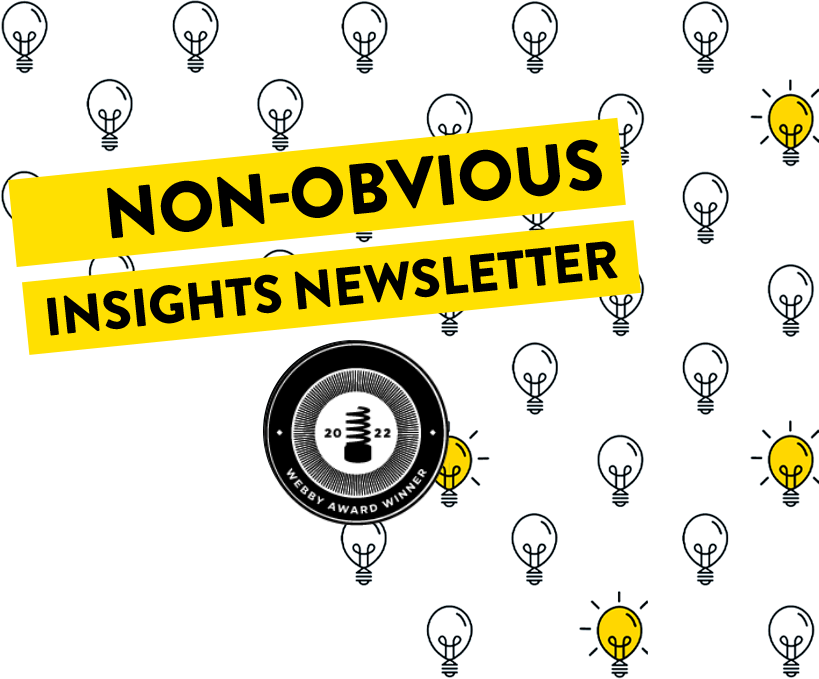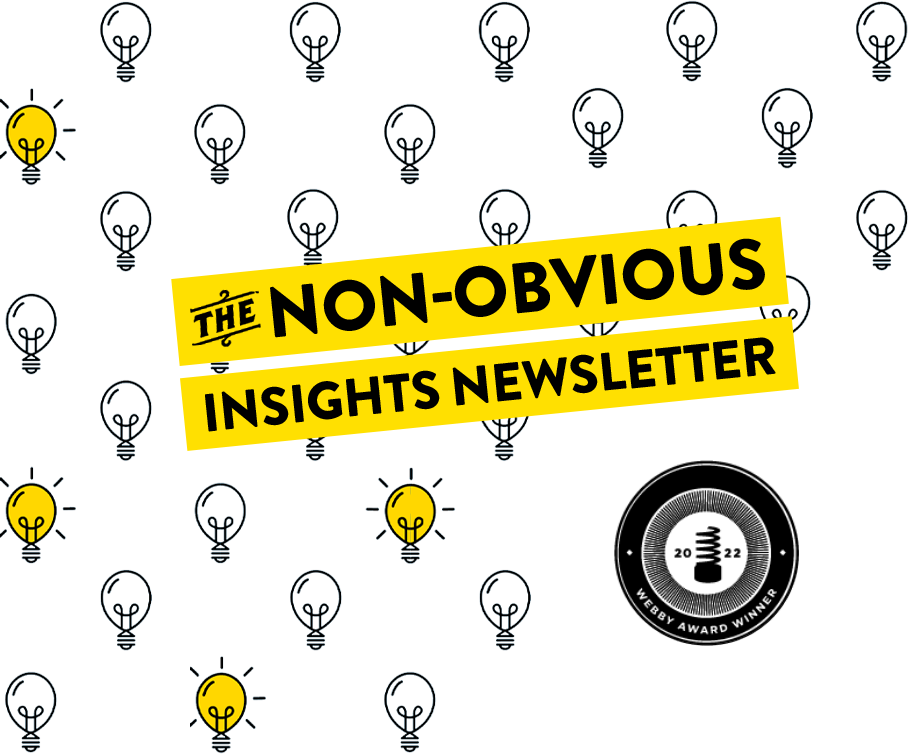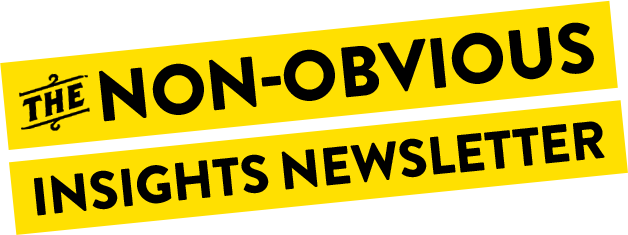Dear Fellow Non-Obvious Thinker,
This week in non-obvious stories, an AI influencer fooled thousands at Wimbledon—and it revealed a deeper truth about the misguided state of influencer marketing. We’re also celebrating 250 years of the United States Postal Service (yes, they invented more tech than you think), imagining how AI could one day charge you more just for talking about a trip, and exploring why optimists may actually think more alike than you’d expect. Plus, a timeless book pick from the ’70s and a new podcast episode that just might change how you feel about trash talk.
Enjoy this week’s stories and stay curious!
How AI Is Exposing the Idiocy of Influencer Marketing
Last week an AI generated influencer went viral at Wimbledon. She wasn’t the first, but there was a firestorm of stories about how she is the latest symbol of the believability crisis we find ourselves in. As one executive from Getty Images explained:
“People are used to seeing curated, almost perfect images from human influencers, achieved through extensive editing, filters and professional photography. Zelu, being entirely AI-generated, naturally embodies this idealised flawless skin, perfect lighting and picture-perfect poses … AI-generated content is currently ‘hyper-polished’, allowing it to seamlessly blend into the existing visual standard that many people have come to expect. The fact that thousands of fans mistook her for real, despite her AI disclosure, points to how our eyes have become conditioned to this hyper-polished aesthetic on social media.”
Yes, this will continue to be a problem. It does expose one of the biggest misperceptions in the world of marketing too … that influencer marketing is about paying someone to hold or be in proximity to your product. There’s a better phrase for this: lazy marketing.
The brands who are spending money solely based on follower counts and simply asking to be “mentioned” are actively wasting their money. Though this case with Mia Zelu isn’t really a marketing story, it does expose a dangerous mistake that many marketers are still making.
Rather than finding influencers who have an authentic possible connection to their product and service and then imagining something interactive and interesting to do with them, they treat influencer marketing like product placement. Both tactics can work – but they are not the same thing.
For me, the whole story of this fake influencer is another wake up call for marketers in any industry that influencer marketing is a waste of time and money when done with lazy thinking.
The U.S. Postal Service Turns 250—So Let’s Celebrate the Innovations They Have Given the World
For over 100 years in the early days of the U.S. Postal Service, the way mail would get sent from small towns involved a crazy method of railway mail clerks attaching pouches to a moving train as it slowed and went through each town. That’s just one of the fascinating stories you can read about this week as the U.S. Post Office gets set to celebrate their 250th anniversary this Saturday.
From helping get commercial aviation off the ground (literally) to inventing the ZIP code system that digitized mail sorting, to developing OCR technology that can read handwritten mail at nearly 98 percent accuracy to first using ecommerce and creating a website all way back in 1994, the USPS has given the world plenty of tech innovations over the years.
More importantly, it has become one of the rarest of government institutions that people trust to consistently deliver on their mission. When you mail something via USPS, the expectation is that it will arrive, and it is rare when it doesn’t. That’s the sort of reputation that is difficult to earn, but in this case is well deserved.
So this weekend, take a moment to share the story of USPS with friends or with your kids. Visit their engaging website and watch some videos of the history of the postal service. If you’re in DC, visit their celebrations at the National Postal Museum. Or maybe go old school and hand write someone a letter.
The Future Will Include AI For Dynamic Pricing … Here’s What Could Happen Next
Here are two stories from this week that don’t seem to be related to one another. The first is about Delta testing AI for dynamic pricing in specific situations. The other is about Amazon acquiring a company that makes a wearable listening device that always captures your conversation. When you put them together, you can start to get a good sense of where dynamic pricing controlled by algorithms is likely to go. Here’s a scenario:
You are having a conversation about a trip you need to take and your preference to have an evening flight. The algorithm hears this and when you go to search for flights, even if the price may have been lower, the evening flight price is dynamically raised because the algorithm knows you may be willing to pay.
Or imagine discussing budgets for any item and having these always-on listening devices such as Google Home or Amazon Echo using the data from these conversations to raise their prices for those items in real time. This is not a science fiction story but a highly likely future scenario. Like Dwight Schrute once said on The Office sitcom, it may indeed be enough motivation for us all to want to keep secrets from our computer in the future.
The “Anna Karenina Principle” That Explains How Optimists Differ from Pessimists
The first line of Leo Tolstoy’s famous novel Anna Karenina offers this observation:
“All happy families are alike; each unhappy family is unhappy in its own way.”
Based on a recent research study, there may be some science that actually proves his point. Neuroscientists studying key brain patterns among people who imagined positive events with a feeling of optimism versus those who did so with pessimism found that the optimists brain patterns were largely similar. For pessimists, those same patterns varied widely. The aim of the study was to try and understand what distinguishes optimistic thinking from pessimism.
Given the conclusions of prior studies showing that optimists have larger social networks, higher acceptance from peers and generally show better physical, mental and social health … this is an important psychological difference to study. There is also evidence to suggest that optimistic versus pessimistic thinking may evolve with age and that extreme optimism may also be unwise because it can prevent someone from adequately preparing for the future.
Reading between the science, the uplifting message of this study is the idea that if people do align in terms of what they are optimistic about then perhaps we can find more agreement about what to prioritize in the world to make us all feel better about it.
The Non-Obvious Media Recommendation of the Week
The Pink Report
I have been reading Dan Pink’s work for years so when he first started his newsletter, I was an immediate subscriber. Aside from sharing non-obvious ideas from his illuminating newspaper column Why Not? – the newsletter also gives you a glimpse into what he’s reading. It’s like a window into the latest curiosities of one of the most popular business writers today. In fact, I wouldn’t be surprised if the topic for his next book emerges from something he originally shares in the Pink Report. For those reasons, Dan’s highly readable newsletter is my pick for the Non-Obvious Media Recommendation of the week.
The Non-Obvious Book of the Week
Up the Organization by Robert Townsend
Up the Organization was published in the mid-seventies, which technically makes it just about as old as I am. The lessons, though, are actually timeless and the book stands apart for an idea that was well ahead of its time … and feels relevant for now too. In case you don’t know Robert Townsend, he was the visionary CEO that helped Avis pioneer their iconic “We’re Number Two. We Try Harder.” advertising campaign that is widely recognized as one of the most successful marketing campaigns of all time.
The subtitle of this book, How to Stop the Corporation from Stifling People and Strangling Profits, should tell you pretty much everything you need to know about the focus of the book and why I say it was ahead of its time but still important today. The structure of the book is a very old school style of using almost note-style lessons, and some of the examples and writing are quite dated. Those shortcomings aside, you will find some very useful forgotten wisdoms in this book that are sure to get you thinking. That alone makes this a worthy read.
About the Non-Obvious Book Selection of the Week:
Every week I share a new “non-obvious” book selection. Titles featured here may be new or classic books, but the date of publication doesn’t really matter. My goal is to elevate great reads that perhaps deserve a second look which you might have otherwise missed.
Even More Non-Obvious Stories …
Every week I always curate more stories than I’m able to explore in detail. Instead of skipping those stories, I started to share them in this section so you can skim the headlines and click on any that spark your interest:
- If You Think We Have Press Freedom, Try Sharing This Story on Instagram
- Mattel’s UNO Social Clubs target Millennials and Gen Z with IRL game nights
- Behind the Viral TikTok Gen Z Stare
- Seattle’s Populus is a Revolutionary Idea: Art Gallery as Hotel
- 8 Things to Know About the First Ever Tesla Diner
- Are Price-Matching Policies Becoming a Thing of the Past?
How are these stories curated?
Every week I spend hours going through hundreds of stories in order to curate this email. Looking for a speaker to inspire your team to become non-obvious thinkers through a keynote or workshop?
Watch my 2024 speaking reel on YouTube >> This Non-Obvious Insights Newsletter is curated by Rohit Bhargava. Copyright © 2024 Non-Obvious, All rights reserved.





